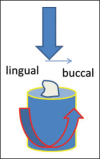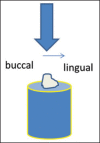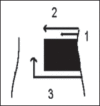The effect of mechanical load cycling and polishing time on microleakage of class V glass-ionomer and composite restorations: A scanning electron microscopy evaluation
- PMID: 24688568
- PMCID: PMC3955302
The effect of mechanical load cycling and polishing time on microleakage of class V glass-ionomer and composite restorations: A scanning electron microscopy evaluation
Abstract
Background: Microleakage is one of the challenging concerns in direct filling restorations. Understanding of its related factors is important in clinical practice. The aim of this study was scanning electron microscopy (SEM) evaluation of marginal integrity in three types of tooth-colored restorative materials in class V cavity preparations and the effect of load cycling and polishing time on the microleakage.
Materials and methods: In this in vitro experimental study, class V cavity preparations were prepared on the buccal and lingual surfaces of 60 bovine incisors. The specimens were divided into three groups each containing 20 teeth: group 1: Filtek Z350, Group 2: Fuji IX/G Coat Plus, Group 3: Fuji II LC/GC varnish. In each group, 2 subgroups (n = 20) were established based on finishing time (immediate or delayed by 24 h). All specimens were thermocycled (×2,000, 5-50°C). In each sub groups, half of the teeth were load cycled. Epoxy resin replicas of 24 specimens were evaluated under field emission-SEM and interfacial gaps were measured. All teeth were then immersed in 0.5% basic fuchsin dye for 24 h, sectioned and observed under stereomicroscope. Data were analyzed with Kruskal-Wallis' test and Mann-Whitney U test and a comparison between incisal and cervical microleakage was made with Wilcoxon test. P < 0.05 was considered as significant.
Results: Load cycling and filling material had a significant effect on microleakage, but polishing time did not. Cervical microleakage in Z350/load cycle/immediate polish and Fuji IX/load cycle/immediate or delayed polish and Fuji IX/no load cycle/immediate polish were significantly higher than incisal microleakage.
Conclusion: It was concluded that the cervical sealing ability of Fuji IX under load cycling was better than Fuji II LC. Under load cycling and immediate polishing Z350 showed better marginal integrity than both Fuji II LC and Fuji IX. The immediate polishing didn't cause a statistically significant increase in microleakage of evaluated tooth-colored class V restorations.
Keywords: Composite resins; dental leakage; dental polishing; glass ionomer cements.
Conflict of interest statement
Figures






Similar articles
-
Effect of Mechanical Load Cycling on Microleakage of Restorative Glass Ionomers Compared to Flowable Composite Resin in Class V Cavities.Front Dent. 2019 Mar-Apr;16(2):136-143. doi: 10.18502/fid.v16i2.1365. Epub 2019 Apr 30. Front Dent. 2019. PMID: 31777855 Free PMC article.
-
Effect of finishing technique on the microleakage and surface texture of resin-modified glass ionomer restorative materials.J Dent. 2000 Jul;28(5):367-73. doi: 10.1016/s0300-5712(99)00075-5. J Dent. 2000. PMID: 10785304
-
Microleakage of Class V resin-modified glass ionomer and compomer restorations.J Prosthet Dent. 1999 May;81(5):610-5. doi: 10.1016/s0022-3913(99)70217-9. J Prosthet Dent. 1999. PMID: 10220667 Clinical Trial.
-
Effect of various surface protections on the margin microleakage of resin-modified glass ionomer cements.J Prosthet Dent. 2001 Sep;86(3):309-14. doi: 10.1067/mpr.2001.116133. J Prosthet Dent. 2001. PMID: 11552169
-
SEM and microleakage evaluation of the marginal integrity of two types of class V restorations with or without the use of a light-curable coating material and of polishing.J Dent. 2008 Nov;36(11):885-91. doi: 10.1016/j.jdent.2008.07.003. Epub 2008 Aug 30. J Dent. 2008. PMID: 18757129
Cited by
-
Effect of cyclic loading on microleakage of silorane based composite compared with low shrinkage methacrylate-based composites.Dent Res J (Isfahan). 2016 May-Jun;13(3):264-71. doi: 10.4103/1735-3327.182188. Dent Res J (Isfahan). 2016. PMID: 27274348 Free PMC article.
-
Effect of Mechanical Load Cycling on Microleakage of Restorative Glass Ionomers Compared to Flowable Composite Resin in Class V Cavities.Front Dent. 2019 Mar-Apr;16(2):136-143. doi: 10.18502/fid.v16i2.1365. Epub 2019 Apr 30. Front Dent. 2019. PMID: 31777855 Free PMC article.
References
-
- Bergenholtz G, Cox CF, Loesche WJ, Syed SA. Bacterial leakage around dental restorations: Its effect on the dental pulp. J Oral Pathol. 1982;11:439–50. - PubMed
-
- Phillips RW. New concepts in materials used for restorative dentistry. J Am Dent Assoc. 1965;70:652–61. - PubMed
-
- Manhart J, Chen HY, Mehl A, Weber K, Hickel R. Marginal quality and microleakage of adhesive class V restorations. J Dent. 2001;29:123–30. - PubMed
-
- Demarco FF, Ramos OL, Mota CS, Formolo E, Justino LM. Influence of different restorative techniques on microleakage in Class II cavities with gingival wall in cementum. Oper Dent. 2001;26:253–9. - PubMed
-
- Beznos C. Microleakage at the cervical margin of composite Class II cavities with different restorative techniques. Oper Dent. 2001;26:60–9. - PubMed
LinkOut - more resources
Full Text Sources
Miscellaneous
